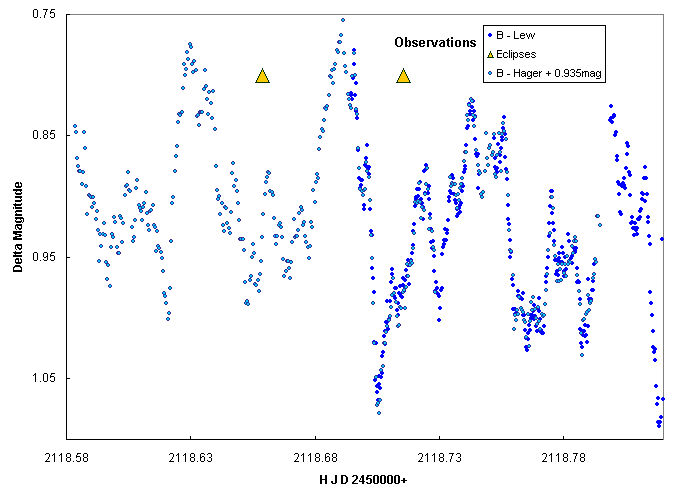
Figure 1 Blue observations of Hager and Cook adjusted to fit (eyeball) by adding 0.935 magnitude to Hager's data.
The first night's data was JD2452118.7 when the star was observed in U, B and H-alpha. Data from all 4 runs on the first night (JD2452118+) is presented below (Figure 2) with blue observations shown in blue, ultraviolet shown in magenta and Hydrogen Alpha in red. In the first figure, Blue data from Hager and Lew are plotted together. The U-B curves for the early part of the night will be added to this page in a few days and the full curve will be updated then also.

Figure 1 Blue observations of Hager and Cook adjusted to fit (eyeball) by adding 0.935 magnitude to Hager's data.
When we look at the H-alpha data, it seems to be similar to the B while the U shows greater amplitude in the flickering and humping (whatever the star is doing). Note: vertical placement of the curves relative to one another is arbitrary. The curves are overlain for the purpose of comparing the variations in each color compared to the other colors. The exposures in H-alpha light were longer than the others (3 minutes for H-alpha versus 16 seconds for Blue). This results in the quickest variations being averaged out.
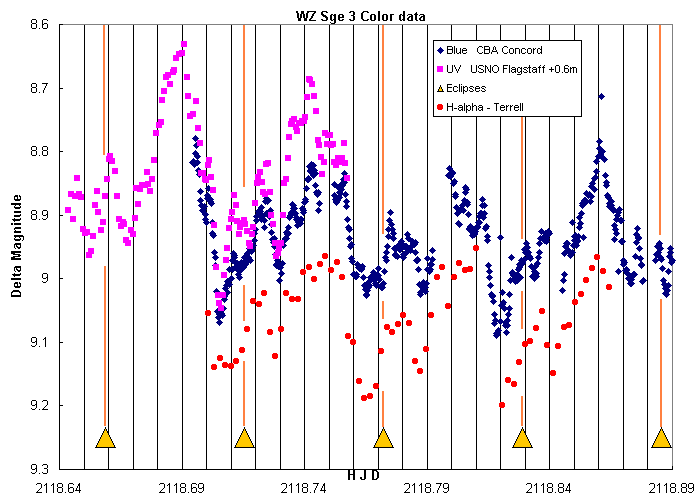
Color curves were formed in the sense of Ultraviolet minus Blue (U-B) by taking the average of the Blue observations immediately preceeding the U observation and subtracting it from the U magnitude. Similar color curves were formed using the Hydrogen Alpha data where the data is presented as a curve in the sense Blue minus H-alpha. These are plotted against the blue data for comparison and interpretation.
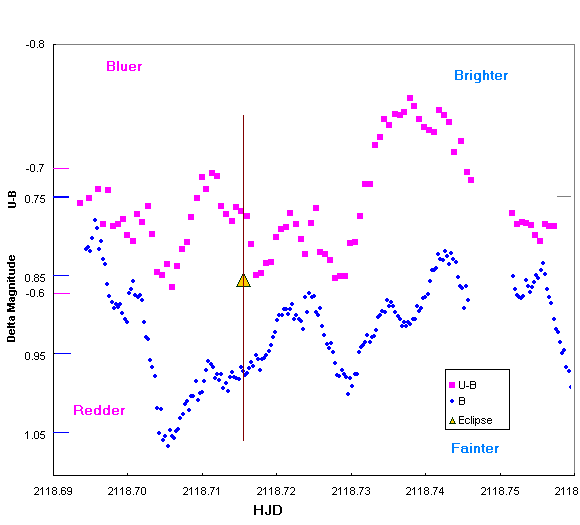
In the U minus B curve above, the color data is plotted with the blue light curve with the color data being shown on an expanded vertical scale. Generally as the star gets brighter, it is also getting bluer (more ultraviolet light). There are a few instances, however, where the behavior of the star shows a departure from this trend. In the section of the light curve around the eclipse, as the system passes throught the eclipse it brightens but the U-B shows the relative contribution of the U being less. The star gets redder.
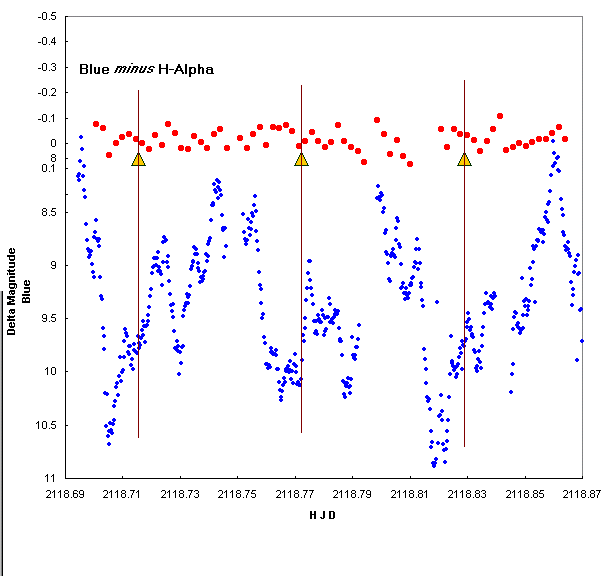
The Blue minus H-alpha curve above is plotted similar to the U-B curve above. It shows relatively little color change - indicating the H-alpha light is varying similarly to the blue. There are some suggestions that the curve trends similarly to the B curve but these are subtle and perhaps indeed even non-existent.
On the second night the star was observed by Henden, Cook and Pullen. It is remarkable how well the B and V data track each other in the second plot especially in view of how violently the star is flickering. Again, the activity in U is greater than in B or V.
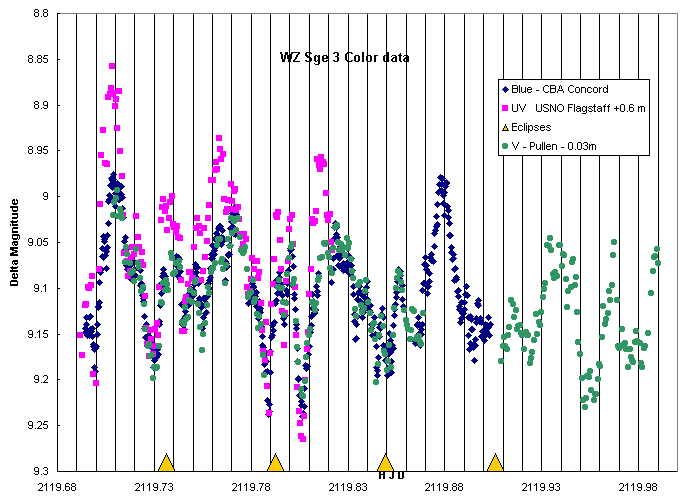
Here again, we have plotted U-B data and also B-V which was determined in the same interpolative manner as for the other color terms. The color data taken in a manner identical to the curves above. Here we have U-B and B-V. The B-V data shows no large fluctuations, but does display a sinusoidal-like variation, but with a period considerably longer than the orbital period of the star (82 minutes). The U-B curve is similar in character to the previous night's curve for U-B showing excesses in U during some but not all of the flickering. The U-B curve is presented below:
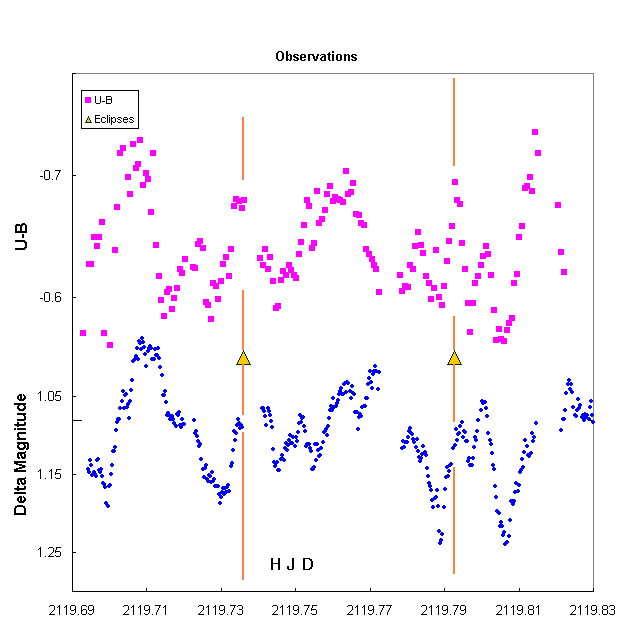
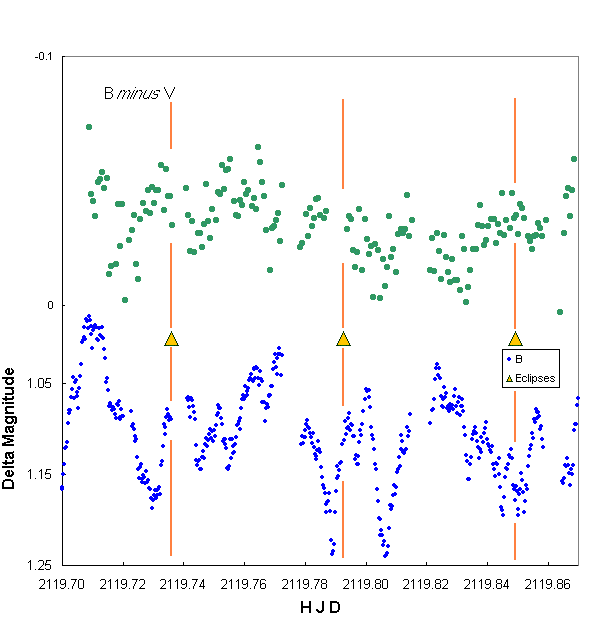
We noted the fact that the eclipse ephemeris for WZ Sge did not seem to coincide with the observed incidents of minimum light in our light curves. We investigated the possibility that there may have been an error in correcting the times of the minima from geocentric (as given on VSNET) to heliocentric. To check, we use the ephemeris
HJD 2437547.72840 + 0.0566878460 E
Patterson, J., H Richman, J. Kemp, PASP 110,404 1998
and come up with (as a single example)
E 257042 2452118.88571 9:15:25
whereas the calculated value from VSNET, corrected, was 2452118.885598 which agrees within a few seconds.
This means that the actual times of minimum light occur earlier than the predicted eclipses. The period of the system is stable (Patterson
et al 1998) so we can rule out any real likelihood that the eclipse itself is occuring early due to period changes. Instead, the shallow eclipse observed at quiescence is actually the eclipse of the hot spot and an eclipse of the disk and the white dwarf is not apparent due to the inclinatinon of the system. Patterson (private communication, 2001) explains "The conventional explanation for why there is a spot eclipse in WZ Sge, but not a white dwarf eclipse, is that the binary inclination is just enough to eclipse the spot, but not enough to eclipse the white dwarf. This restricts [the inclination]to a narrow window, something like 70 The WZ Sge system is noteworthy for having low mass transfer rates and in these systems a faint disk around the white dwarf is anticipated. The bright spot is subject to flickering, and that would disappear in eclipse. There is some evidence that this may be happening. In the B light curve on JD2452118.7 the eclipse times seem coincide with times when the scatter is smaller and then the flickering - from the eclipsed hotspot - is reduced.
It seems that the depth of the eclipse is greater in H-alpha than in B when the curves are overlaid so that the maxima coincide. This is most evident in the plot where there is no vertical offset in the H-alpha data. This re-plot of the first night's data shown below. The vertical grid lines are presented to aid in visualizing the simultaniety (or lack thereof)of the flickering and other variations in the different colors. Krzeminski and Kraft (1964 ApJ, 140,921) conversely found the primary eclipse to be displaced relative to a secondary eclipse, but in the opposite direction. Further, they found that the emission lines decreased by a factor of one half compared to the white dwarf continuum during the primary eclipse. They ascribe the eclipse to the eclipse of the disk (they term it "ring") and the stream of matter from the secondary. Our eclipse observations support this interpretation with the realization that it is the hot spot in the system which is eclipsed at primary minimum in quiescence and the eclipse of the bright inner disk is the cause of the decrease in brightness at primary minimum in outburst.
Joe Patterson sheds some light on the subject of the eclipses: "The conventional explanation for why there is a spot eclipse in WZ Sge, but not a white dwarf (wd) eclipse, is that the binary inclination is just enough to eclipse the spot, but not enough to eclipse the white dwarf. This restricts to a narrow window, something like 70 The star seems to get a bit BLUER in both color curves (above and below) just prior to the eclipse, as if a hot spot were UNCOVERED during this time. Looking at the Blue light curve at those times, we do note the star is brightening considerably at those times, but brightens even more following the eclipse times. It seems reddest DURING the eclipse. With the interpretation that the hot spot is being eclipsed - even with lots of other sources of light in the system - this color twitch seems explainable by having the hottest part of the system covered when it is reddest.
Later in the outburst, on JD 2452137.6, Doug West and Tim Hager observed the star, West in Infrared and Hager in Blue. The observations are plotted together below, with little inference that can be drawn other than perhaps the I is not varying or maybe similar behavior is seen in I as in B, however the data is not robust enough to give support to either conclusion.
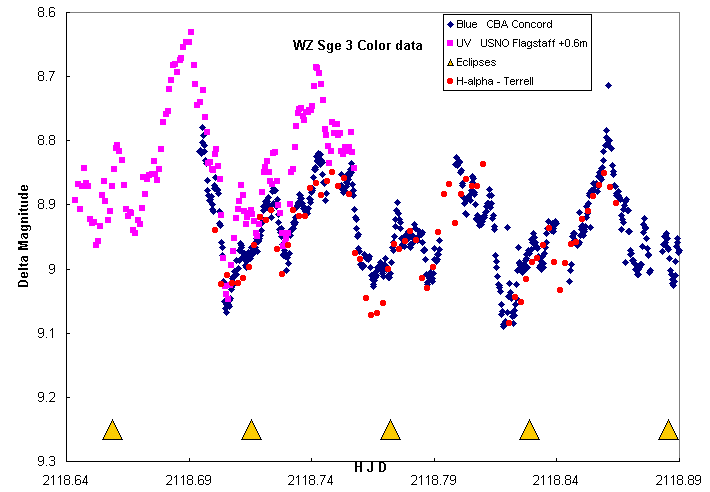
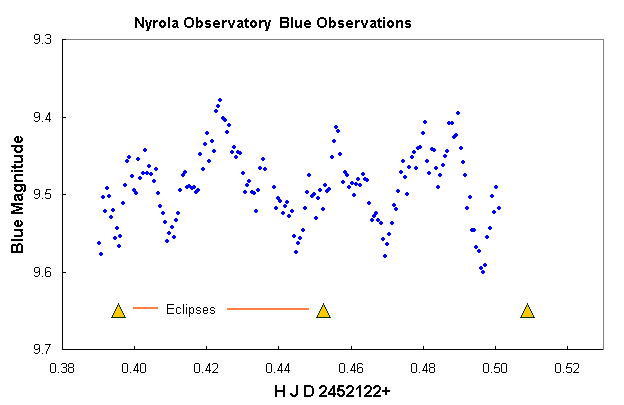
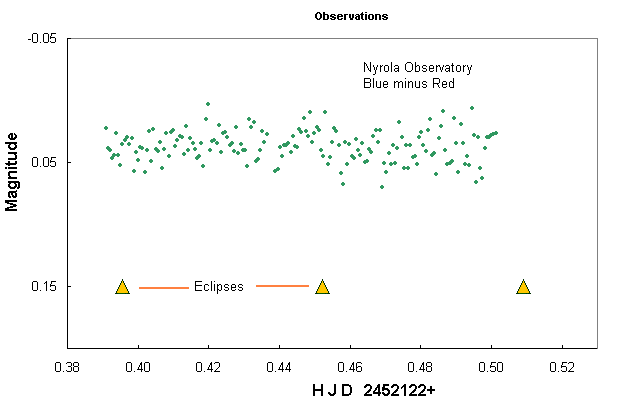
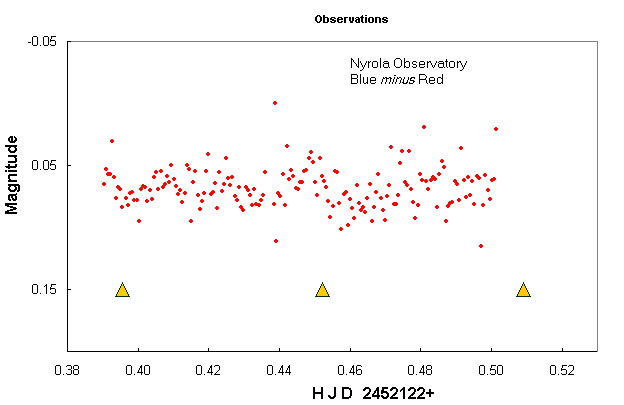
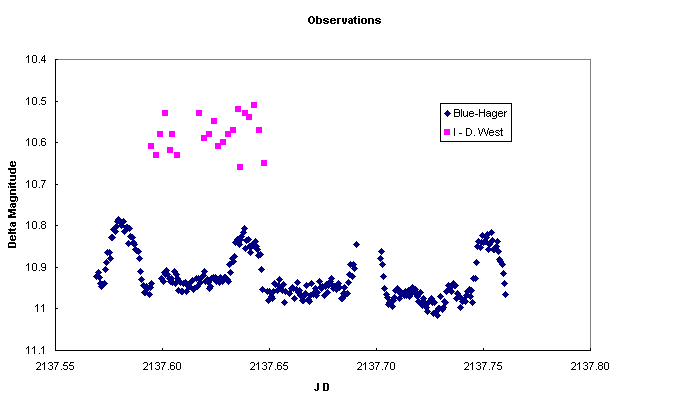
Lew's work on this star for all nights observed
Lew's CCD page
Dirk's Eclipsing Binary Page
US Naval Observatory Flagstaff Station
Nyrola Observatory